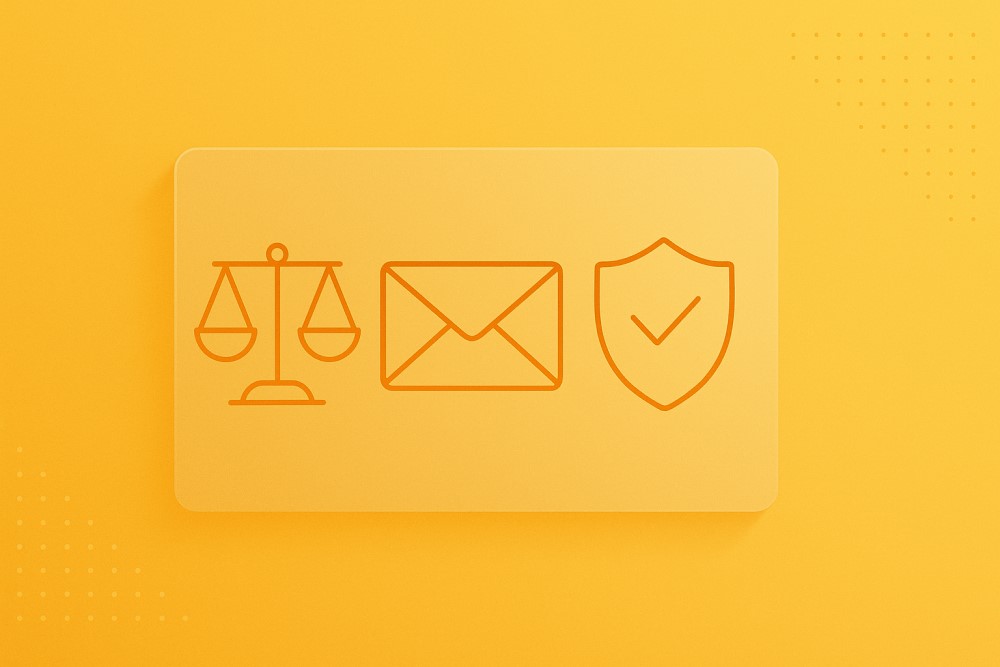Is Cold Email Legal in the U.S.? A Plain-English Guide (What Applies, What Doesn’t)

Yes—cold email is legal in the U.S., as long as you follow the CAN-SPAM Act. There’s no B2B exemption in CAN-SPAM: marketing email to businesses still has to meet the law’s requirements.
What does CAN-SPAM actually require (in normal words)?
Think of CAN-SPAM as the “rules of the road” for commercial email (anything that primarily promotes a product/service). Transactional notices (receipts, password resets, shipment updates) are treated differently.
Here’s the gist, explained:
- Be truthful about who you are.
Your “From/To/Reply-To” and routing info must be accurate and identify your business. No spoofing. - Subject lines must match the message.
If the subject promises “2025 webinar replay,” the email should actually deliver that—no bait-and-switch. - Say it’s an ad (clearly).
You have flexibility in wording—just make the promotional nature obvious. - Include a physical mailing address.
A valid street address, PO Box, or private mailbox counts. - Give an easy way to opt out—and honor it fast.
Offer a clear unsubscribe (reply address or a single-page web link works). You must process opt-outs for at least 30 days after sending and honor them within 10 business days. Don’t charge a fee or require extra personal info beyond the email address. Don’t sell/transfer unsubscribed addresses (except to a vendor helping you comply). - You’re responsible even if an agency presses “send.”
If a vendor emails on your behalf, you can still be on the hook.
Quick definitions: “Commercial” vs. “Transactional/Relationship.”
CAN-SPAM looks at the primary purpose. Pure promos = commercial (full rules apply). Pure transactional updates = mostly exempt (still no deceptive routing). Mixed emails are judged by what dominates and what the subject suggests.
Do I need consent (opt-in) to cold email in the U.S.?
No federal opt-in is required for commercial email—opt-out is the rule in the U.S. But you must follow the CAN-SPAM requirements above (identity, address, opt-out, etc.). Penalties can be steep per violating email, so the details matter.
What about TCPA and the Do Not Call (DNC) list—do those apply to email?
- TCPA covers calls and text messages (yes, texts are treated like calls in this context), not email. If you’re doing SMS or telemarketing calls, separate rules apply—including “prior express written consent” for many promotional texts and evolving consent rules (like the FCC’s newer one-to-one consent clarification).
- DNC Registry is about telemarketing calls to home/mobile numbers—not email. (It’s a list telemarketers must scrub against to avoid calling registered personal numbers.)
TL;DR: CAN-SPAM governs email. TCPA/DNC govern calls/texts, not email. If you cold email and cold call, you must comply with both frameworks.
Do any state privacy laws change cold email?
They don’t flip U.S. email to an “opt-in only” regime, but they can affect how you handle data (disclosures, rights, retention). For example, California’s CPRA ended prior B2B exemptions in 2023—meaning some B2B personal info is now subject to consumer rights (notice, access, deletion, etc.). You should review privacy disclosures and request workflows if you market into California; similar state laws (e.g., Colorado’s CPA) impose transparency/rights based on thresholds.
Deliverability matters too (even if you’re compliant)
Gmail and other inbox providers now enforce stricter sender rules—especially for bulk senders (5,000+/day to Gmail): authenticate with SPF + DKIM + DMARC, align your From: domain, and support one-click unsubscribe. These aren’t “laws,” but failing them means your email may be rejected or spam-foldered even if you’re CAN-SPAM compliant.
A practical compliance (and sanity) checklist
- Set the right category per email. If it’s promotional, include the advertisement disclosure, address, and opt-out link. If it’s transactional (e.g., a receipt), keep it clearly transactional.
- Build footers you never have to rethink. Keep your postal address and a clear “unsubscribe from marketing emails” link on all promos. Process opt-outs within 10 business days.
- Authenticate your domain. Add SPF, DKIM, and DMARC (p=none is acceptable to start) and keep spam complaint rates low. Support one-click unsubscribe for bulk mail.
- Keep your list clean. Verified, accurate B2B emails reduce bounces and complaints—which protects your reputation and deliverability. (If you need clean data, see our Plans & Pricing.)
- If you also call or text, separate workflows. Apply TCPA/DNC requirements to calls/SMS; don’t assume CAN-SPAM rules cover those channels.
Plain-English footer you can copy
You’re receiving this because we believe our product is relevant to your role.
Our address: 123 Example St, City, ST 00000
Prefer not to hear from us? Unsubscribe here: example.com/unsubscribe
Customize the address and link (and keep the link as a one-click opt-out for good Gmail/Yahoo hygiene).
FAQ (the stuff people ask)
Is cold email legal if I send to work addresses only?
Yes—but it’s still “commercial email,” so CAN-SPAM applies. There’s no special B2B exemption. Include your address, identify the message as an ad, and provide/ honor opt-outs.
If someone opts out, when do I have to stop?
Within 10 business days. And don’t require anything beyond their email address or a single-page web form to process the opt-out.
Do I need prior consent for cold email?
Not under federal law—but consent (or at least very tight targeting) lowers complaints and helps inbox placement. For texts/calls, that’s different (TCPA).
What’s “commercial” vs. “transactional”?
Commercial promotes a product/service; transactional facilitates an existing relationship (receipts, account notices). Mixed messages are judged by the primary purpose and what the subject/body emphasize.
The bottom line
Cold email is legal in the U.S. when you follow CAN-SPAM. Keep your identity transparent, subjects honest, address visible, and opt-outs easy (and fast). If you also use calls or texts, add TCPA/DNC compliance. And for deliverability, meet Gmail’s modern sender requirements so you actually land where people can read you.
When you’re ready to start with clean, verified B2B contacts, build your list here: Plans & Pricing.
Helpful official resources
- FTC CAN-SPAM Compliance Guide (official rules & examples). Federal Trade Commission
- FCC TCPA updates & consent (texts/calls). Federal Register+1
- FTC DNC overview/FAQs (applies to calls, not email). Consumer Advice
- Gmail sender requirements (2024+). Google Help
This article is informational and not legal advice. For specific situations, consult counsel.




